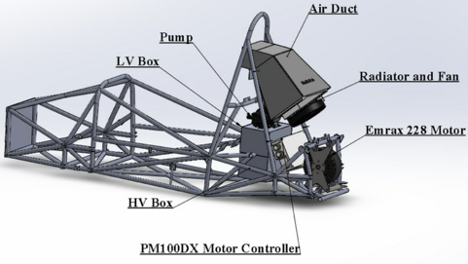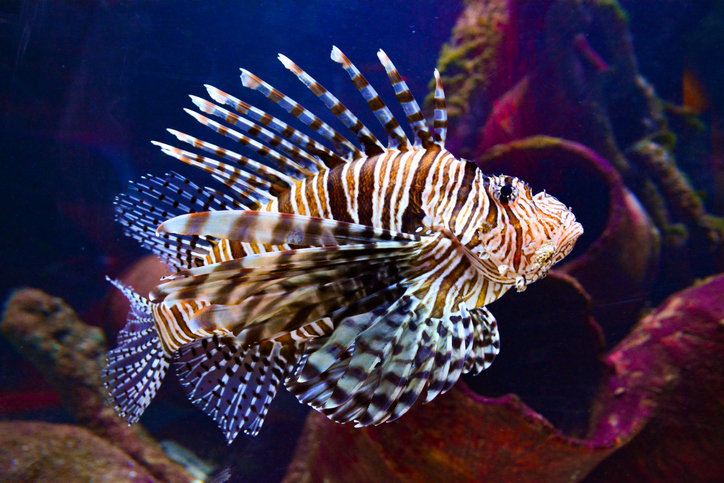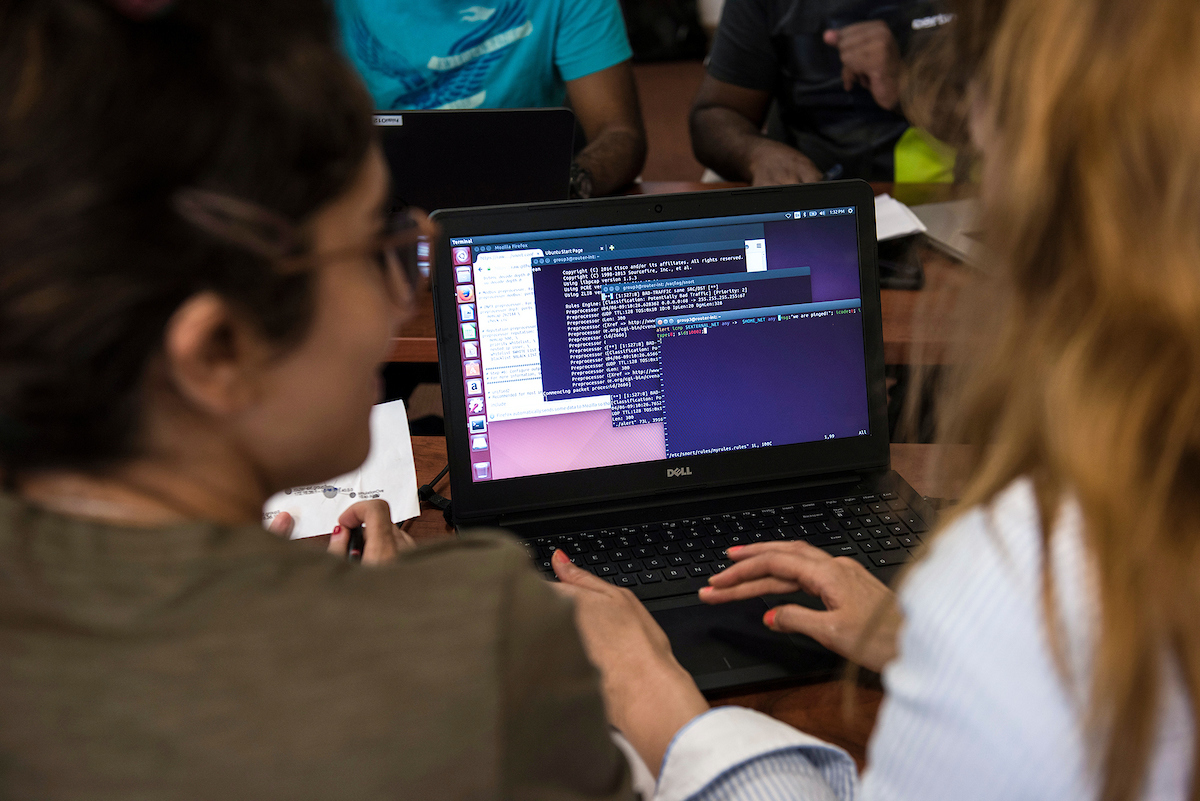5 Projects Prepping Seniors for Careers in Computer Engineering and Sciences
The university’s flagship project and a Panther rite of passage, the engineering and science student design and research program has existed in some form or another almost since the university’s inception in 1958.
A multidisciplinary capstone project for all science and engineering seniors, senior design is a yearlong course in which students bring a project from concept to completion, simulating a real-world work environment and culminating in the Northrop Grumman Engineering and Science Student Design Showcase, where teams present their work and field questions from peers, faculty, industry professionals and local leaders.
Due to the COVID-19 pandemic, this year’s seniors, like the rest of the world, had to adapt to unforeseen challenges, like in-person class cancellations and short-notice closure of the L3Harris Student Design Center. While most students’ projects look a little different from how they had envisioned them at the beginning of the year, we are proud to continue the tradition of showcasing them to their peers, community and, most important, prospective employers through the Northrop Grumman Virtual Student Design Showroom.
Prepare to be impressed—the showroom hosts descriptions, photos, video presentations, display boards and more for the more than 100 projects completed this year.
Here, we’ve compiled a list of
5 Projects Prepping Seniors for Careers in Computer Engineering/Sciences
1. Florida Tech Course Planner
While the prospect of a fresh new semester and the chance to mold the ideal schedule may excite students, muddling through the course registration process using traditional, ineffective registration systems almost certainly does not. Enter the Florida Tech Course Planner.
“The overall goal of the Florida Tech Course Planner is to improve the course planning process for Florida Tech students and advisors by creating a web application that presents registration information in a consistent and available way, assists with the creation of student schedules and gives an outlook on degree requirements for Computer Science (CS) and Software Engineering (SWE) students so they understand their program plan and stay on track to graduate on time.”
Top Features:
- Section Planner: Navigate the course catalogue.
- Schedule Planner: Visualize course options and conflicts, plus automated registration form fill-in.
- Degree Planner: Stay updated on what courses remain for your degree program plan.
Team Members
Xu Zhen (team lead), Ahsi Lo, Brandon Sawyer, Thomas Winderweedle
Faculty Advisor
Ryan Stansifer, associate professor, computer engineering and sciences
2. Reducing Damaged Freight

After months comparing products and scanning reviews, not to mention the hourlong personal debate about whether to splurge on expedited shipping, your package has arrived—damaged.
To reduce the number of packages—and dreams—shattered, the Reducing Damaged Freight application implements an algorithm, considering factors like weight, volume and fragility scores, to identify and mitigate the most common risks for package placement within a trailer. The project also includes a graphic user interface, enabling users to easily navigate and store items, as well as a simulation showing the damage an item would incur if placed in a given spot.
According to the team’s research, damaged products cost shipping companies close to $30 billion a year, which translates to companies increasing prices on various other services.
“The damage to packages happens for many different reasons, but the technology used in the shipping industry is antiquated and subpar. … However, with the use of a placement algorithm, the number of damaged packages each year will go down, in turn, leading to less money being lost.”
Team Members
William Ferrick (team lead), Chad Boyer, Jordan Murray, Connor Roth
Faculty Advisor
Keith Gallagher, associate professor, computer engineering and sciences
3. The Music Assistant
Tend to sing off-key? The Music Assistant web app is here to help. Targeted toward choirs—both members and directors—the app gives real-time feedback on how accurately a person’s vocals align with sheet music and then generates exercises designed to perfect weak areas. The Music Assistant tracks members’ progress as they practice and work their way through the personalized improvement exercises, and choir directors receive various data summaries, so they can work with the member accordingly.
“Our team had to combine several tools together, including alphaTab for rendering the digital sheet music, P5 for drawing the real-time feedback and ML5 pitch detection for listening to, and recording input from, the user. While these tools exist on their own, we had to combine them in a new and unique way.”
In addition to tweaking the performance grader so that it was both strict enough to recognize inaccuracies and forgiving enough to ignore imperceptible performance deviations, the team’s biggest challenge was determining how to demonstrate that the tool worked, which it did by successfully onboarding two choirs.
Team Members
Daniel Griessler (team lead), Daniel Levy, Javier Munoz
Faculty Advisor
Thomas Eskridge, associate professor, computer engineering and sciences
4. SAE Formula Electric

As a second-year student design project, SAE Formula Electric aimed to build upon the creation of a Florida Tech electric vehicle to eventually compete in the Formula SAE (formerly Society of Automotive Engineers) student competition. A combination of three electrical teams and one mechanical team, the project carried over the accumulator and high-voltage test-bed designs from last year and worked to produce a high-voltage box, low-voltage box, user interface and cooling system.
The biggest challenges the teams faced were due to design restrictions and subsystems’ integration dependency, as well as meeting SAE requirements, high-voltage restrictions and thermal design. Some unforeseen safety hazards arose as members worked their way through the project, too.
“The accumulator design did not provide capability for maintenance and repair; therefore, the team decided to disassemble the accumulator to mitigate safety hazards. The disassembly of the accumulator affected all of the subteams because it prevented the use of the motor controller and motor, and subsequently, the integration of all the subsystems. The test plan was modified to overcome the complications.”
This year’s team already has some ideas for how next year’s members can improve the project going forward.
Team Members
Tomas Lavigne (team lead), Bader Taher, Abdulla Alsereidi, Abdullah Alsharif, Kuron Seabrun, Jeff Walker, Humaid Al Zarai, Abdullah Al Bulushi, Thomas Gribben, Xianoho Wang, Julanda Al Shukaili, Pijuan Yu, Khaleifah Alyammahi, Nicolas Irurita, Duwan Equez, Ziyuan Wan
Faculty Advisor
Kenneth Gibbs, adjunct instructor, computer engineering and sciences
5. Lionfish Remediating Invasion Device

For 35 years, marine environments in the Atlantic Ocean, the Caribbean and parts of the Gulf of Mexico have incurred significant damage caused by the invasive lionfish. While people have attempted numerous removal methods, none has been particularly effective.
Improving upon a Lionfish Remediating Invasion Device that a student design team developed last year, this year’s team designed an automated version to trap lionfish during their peak activity hours. Able to run for about one week or until about 30 adult lionfish have been captured, the device is placed at a depth of 100 feet until it is brought to the surface for maintenance.
A master controller transfers control of the trap between three of four subsystems: breakbeam, detection, gate-control and power-management.
“When a fish enters, a Raspberry Pi, part of the detection subsystem, takes an image of the fish and then executes a computer vision algorithm to determine whether the fish in the trap is a lionfish. The result computed by the Raspberry Pi determines if the fish is then captured (in case of a lionfish) or released back to the ocean (in case it is not).”
Team Members
Josias Moukpe (team lead), Zhenyuan Niu, Jiagen Guo, Fan Zhang, Wanxuan Li, Jia Zhang, Fahaid Alhajri
Faculty Advisor
Kenneth Gibbs, adjunct instructor, computer engineering and sciences
Impressed and ready for more? Check out:
- 2 Projects Prepping Seniors for Careers in Mathematical Sciences
- 4 Projects Prepping Seniors for Careers in Biomedical and Chemical Engineering/Sciences
- 5 Projects Prepping Seniors for Careers in Ocean Engineering and Marine Sciences
- 4 Projects Prepping Seniors for Careers in Aerospace, Physics and Space Sciences





